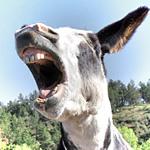Weather Proverbs and Folklore
22 September 2011
Wisdom, truths, untruths, morals, common sense and traditional beliefs combine to form weather folklore and the popular and often repeated phrases known as proverbs. With some analysis, it is possible to see how such proverbs were developed over centuries using logical and causal relationships between observations and natural weather events.
Weather folklore and its quirky proverbs derived from simple weather, plant and animal observations were handed down through word of mouth long before Greek philosopher Aristotle wrote his study, Meteorology, in 350BC. Weather proverbs usually contain foretelling or predictive statements in the form of weather rules and signs. Some farmers and sailors still depend on weather proverbs today, including Hark I hear an asses bray, we shall have some rain today and Red sky at night, shepherd's delight. Red sky in morning, shepherd's warning.
Modern interpretations
Hark I hear an asses bray, we shall have some rain today
Farmers noted that donkeys braying in the morning were followed by a wet day.
Red sky at night is a shepherds delight, red sky in the morning is a shepherds warning
Red glow at dusk is an indication that the next day will be fine and sunny. While red at dawn indicates stormy weather.

Red sky sunrise at Uluru, Northern Territory. Photograph: Karna Nair.
A little bit of red sky history
Travelling by word of mouth, a variant of Red sky at night was first recorded in Matthew XVI from the Wycliffe Bible in 1395;
When it is evening, ye say, it will be fair weather: for the sky is red. And in the morning, it will be foul weather to day: for the sky is red and louring.
Another version is found in Shakespeare's poem, Venus and Adonis; Like a red morn that ever yet betokened, wreck to the seaman - sorrow to the shepherds.
Proverbs, superstitions and science
Cleverly constructed proverbs often relate closely to superstitions. For this reason some question their dependability and accuracy. Proverbs are also challenged for lacking the scientific precision of modern meteorology. They predict weather proceedings that may or may not occur within minutes, hours, days, weeks, months, seasons, or years. The most accurate and logical proverbs are those whose predictions reflect basic environmental rules, such as clear moon, frost soon. This is suggestive as when the sky is clear, there is no insulating cloud cover to prevent frost during winter.
Animals in weather folklore
Animals play a significant part in weather folklore and proverbs, with their behaviour being interpreted to indicate weather proceedings. In addition to the braying of donkeys example mentioned above, early French anglers depended on their pet cats' behaviour for weather signs. Watching closely, it is said that a cat's pupils will increase in size when it's high tide and decrease in size when it's low tide. Some may have seen the film, Groundhog Day, based on the US and Canadian holiday of 2 February. If a groundhog sees its shadow when it emerges from its burrow (that is, if it is a sunny day), it will retreat back into its burrow, indicating that winter will continue for six more weeks.
Popular weather proverbs
- When halo rings the moon or sun, rain's approaching on the run.
- When ants travel in a straight line, expect rain; when scattered, expect fair weather.
- Bees will not swarm before a storm.


Comment. Tell us what you think of this article.
Share. Tell others.